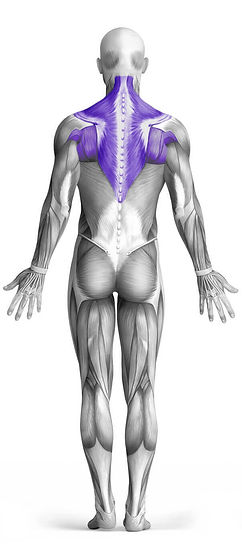T-Bar Row 101 Video Tutorial
0

Timer
Hour
Minute
Second
Stopwatch
00:00:00:00
Overview
The T-Bar Row is a compound exercise primarily targeting the upper back muscles, specifically the rhomboids, traps, and lats, while also engaging the shoulders, biceps, abs, and lower back for stability and support. Performed by positioning a barbell between the legs and lifting the weighted end toward the torso with a rowing motion, this exercise effectively strengthens and thickens the back, improving posture and overall pulling strength. Maintaining a neutral spine and controlled movement throughout helps avoid strain on the lower back, and the T-Bar Row's standing position encourages core activation, making it a well-rounded choice for building back strength and endurance.
How to Perform
Stand with the barbell positioned between your legs, gripping it firmly with a V-grip handle placed securely around the bar's end.
Hinge at the hips, lowering your torso until it is almost parallel to the floor or slightly higher, while maintaining a strong, neutral spine.
Engage your core, and begin the row by pulling your elbows backward, focusing on squeezing your shoulder blades together to activate the upper back.
Continue to pull the bar toward your torso until the weights nearly reach your chest, keeping the movement controlled and avoiding momentum.
Slowly lower the bar back to the starting position, maintaining tension throughout to protect your lower back and maximize engagement of the target muscles.
Repeat for the desired number of reps, focusing on maintaining form and control in each movement.
Tips
Test different head positions to find the one that feels most comfortable, whether it's looking straight ahead or slightly tucking your chin to pack your neck.
Engage your core by maintaining some tension in your abdominals while rowing the bar toward your body, preventing excessive arching in your lower back.
Focus on controlling the movement, avoiding any swinging or momentum. Each repetition should be deliberate and steady.
Keep your head aligned with your spine throughout the motion. Do not allow your head to push forward as you pull the bar.
Make sure your shoulder blade moves naturally with your rib cage. Avoid locking it down and instead focus on proper scapular movement to engage the full range of motion.
How Not to Perform
Avoid Using Momentum: Do not jerk or swing your body to move the bar. Keep the motion smooth and controlled to ensure the focus remains on your upper back and not on using momentum to lift the weight.
Do Not Arch Your Lower Back: Keep your spine neutral and avoid excessive arching in your lower back. Engaging your core will help stabilize your torso and prevent strain on the spine during the movement.
Don’t Shrug Your Shoulders: Avoid letting your shoulders rise toward your ears. Focus on retracting your shoulder blades rather than shrugging them up, as this targets the upper back muscles more effectively.
Don’t Overextend the Elbows: When pulling the bar, avoid overextending or locking out your elbows. This can shift the focus away from the upper back and biceps, reducing the effectiveness of the exercise.
Avoid Pulling the Bar Too High: Don’t try to pull the bar all the way to your chest or above. Instead, aim to stop the movement when the bar reaches the point where your upper arms are parallel to the floor or slightly above.
Don’t Neglect Proper Grip: A weak or shifting grip can lead to an unstable movement. Make sure to grip the bar firmly with both hands, ensuring your wrists are neutral and not overly bent.
Avoid Dropping the Bar Too Quickly: On the eccentric phase (lowering the bar), do not let the weight drop too quickly. Control the descent to maintain tension on the muscles being worked and reduce the risk of injury.
Don’t Hyperextend the Neck: Be mindful of your head position. Avoid jutting your head forward or excessively tilting it up. Keep it neutral to avoid strain on the neck and maintain proper spinal alignment.
Don’t Let the Elbows Flare Out: Keep your elbows tucked close to your body as you row. Flaring them out can shift the focus away from the upper back and potentially strain the shoulders.
Avoid Using Too Much Weight: Start with a manageable weight to ensure you can perform the exercise with good form. Lifting too heavy can lead to improper technique and increased risk of injury.
Variations
Variations of fitness exercises refer to different ways of performing a specific exercise or movement to target various muscle groups, intensities, or goals. These variations aim to challenge the body differently, prevent plateaus, and cater to individuals with varying fitness levels.
Alternatives
Alternative exercises in fitness refer to different movements or activities that target similar muscle groups or serve the same training purpose as the primary exercise. These alternative exercises can be used as substitutes when the original exercise is unavailable or challenging to perform due to various reasons such as equipment limitations, injuries, or personal preferences.



